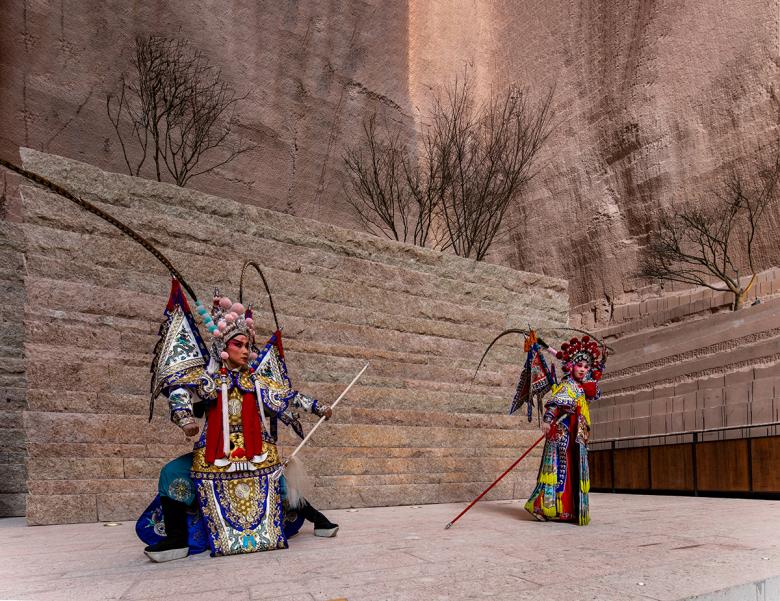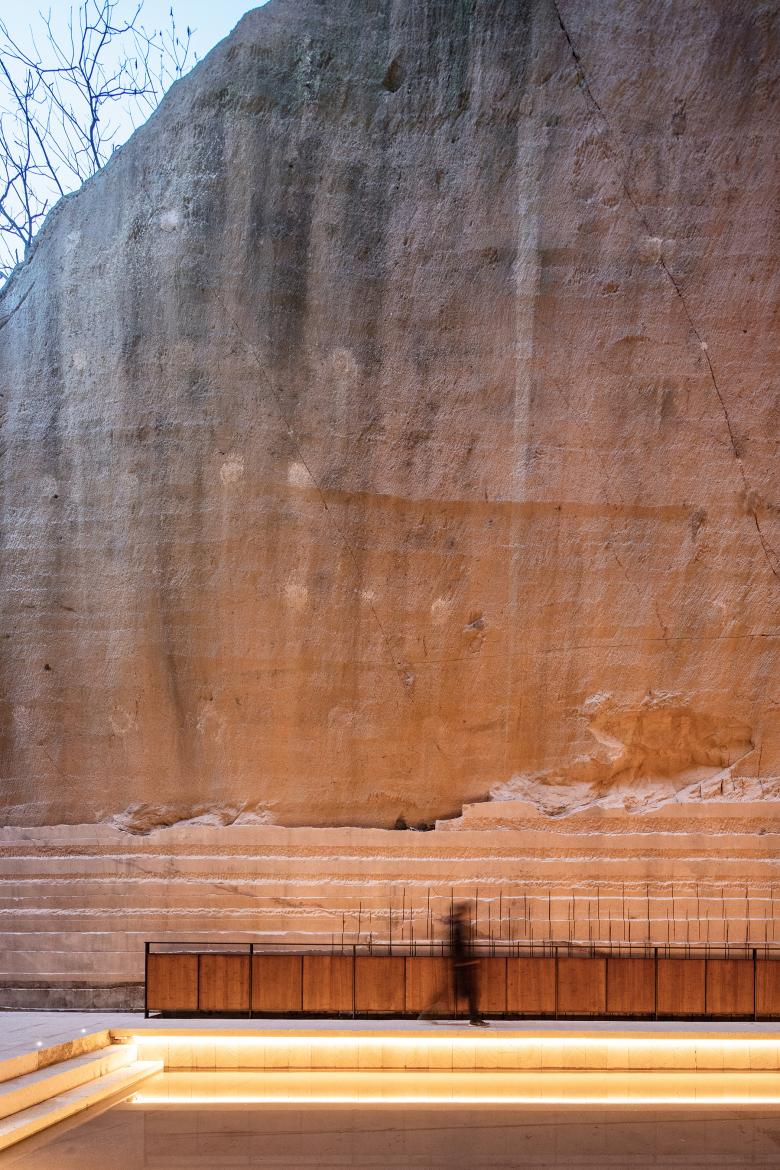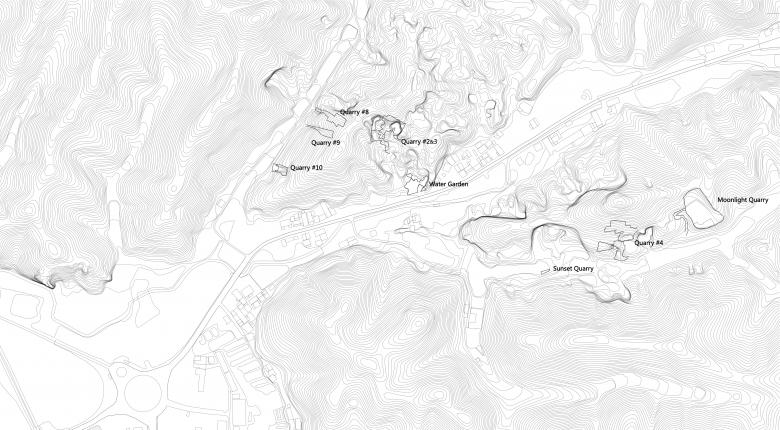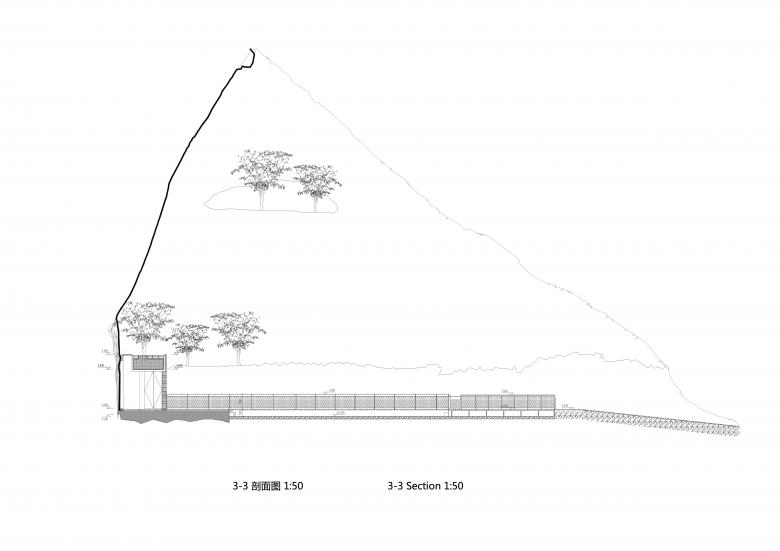Quarries as Spatial Resource
Eduard Kögel
11. maart 2022
Photo: Wang Ziling © DnA Design
In April 2021, Xu Tiantian and her office DnA_Design and Architecture were invited by the local authority of Jinyun County to develop ideas for the conversion of former quarries. Those responsible had become aware of Xu Tiantian through her recent involvement in the neighbouring county of Songyang, where using a strategy that she describes as ‘architectural acupuncture’ her projects brought new life to old villages with comparatively little intervention.
Jinyun County has more than 3000 open quarries that were excavated by small family businesses, especially in the last quarter of the twentieth century. The destruction they caused to the topography and the landscape is an ongoing debt that must be remedied. The dense tuff rock was mostly quarried by hand and used locally for the construction of buildings of up to five storeys, bridges and sculptures. Mining was stopped by the administration at the turn of the millennium due to the ecological damage it caused and the excessive number of quarries being operated. But the question remained unresolved as how to deal with this legacy.
Photo: Wang Ziling © DnA Design
In discussion with Xu Tiantian, nine former quarries were selected for inclusion in a project that will also see the construction of an information centre at a later date. A footpath connects the quarries over a distance of one kilometre and provides access to a range of new public places for tourists and the local population; such as a tea house, a demonstration-exhibition of old stonemasonry, a kind of library, a restaurant or simply places to stop in the landscape. Safety was a key factor in the selection of the quarries and the question of how much intervention would be required to implement necessary safety measures.
Photo: Wang Ziling © DnA Design
A theatre stage has been integrated into quarry no. 9, shown here as one example. The rockface was cut as if with a knife, to create a long narrow entrance that widens in plan into an approximately rectangular space and tapers vertically like a very high roof towards a narrow-slit opening that lets daylight through. The wall surfaces of the lower section are sheer and straight due to the use of cutting machinery, while the surfaces of the upper conical-like space were formed manually by the past quarrying activity. The inner cathedral-shaped room is roofed over at the back and although this shape was created by chance it has excellent acoustic properties. After making various tests, experts improved the acoustic performance with flooring, panels in the side railing and other sound-absorbing measures, so that the space can be used for a variety of purposes.
Photo: Wang Ziling © DnA Design
The existing conditions and the technical optimisation make this venue suitable for lectures, performances or the staging of the traditional Wu opera common only to this region and an attraction for local audiences as for visitors. Skilfully integrated artificial lighting creates a festive atmosphere that emphasises the spatial qualities and brings the massive, rough wall surfaces into focus.
Photo: Wang Ziling © DnA Design
When it rains, water collects in the covered inner space where the floor surface is slightly lower and mirrors the surroundings. Depending on the incidence of the light, the moving ripples are reflected on the walls of the space, or the sound of dripping water can be heard as an additional acoustic experience.
Photo: Wang Ziling © DnA Design
The question of what to call these spatial conversions and installations is hard to answer. Architecture is typically concerned with the creation of spaces, volumes, façades, openings or roof forms, all categories that are not that relevant here. An already created collection of spatial volumes carved organically into the rockface became the basis for a kind of interior architecture combined with landscape planning or land art, that with relatively little intervention can produce public places with a new quality and transform what was an ecologically problematic legacy into a social, cultural and economic benefit for the local population.
Photo: Wang Ziling © DnA Design
So far three quarries (numbers 8, 9 and 10) have been completed. These can be seen together with the concepts for the other six quarry conversions in a spectacular installation at Berlin’s Aedes Architecture Forum from 19 March to 5 May 2022: JINYUN QUARRIES—THE QUARRY AS STAGE. From economic exploitation to ecological reuse, XU Tiantian / DnA_Design and Architecture, Beijing.
Location: Xiandu Street, Jinyun County, Lishui City, Zhejiang Province, China
Program: Theatre
Client: Jinyun County Culture tourism Development Investment Co. Ltd.
Architecture Design: Xu Tiantian / DnA_Design and Architecture
Lighting Design: Zhang Xin Studio, Architecture Department of Tsinghua University
Acoustic Design: Professor Yanxiang, Tsinghua University Acoustic Lab
Sustainable Ecological Environment Design: Professor Borong LIN, Key Laboratory of Eco Planning & Green Building (Tsinghua University), Ministry of Education
Safety Evaluation: South Zhejiang Comprehensive Engineering Institute Co. Ltd of Investigation and Mapping
Structure Strengthening Engineering: The Architectural Design & Research Institute of Zhejiang University Co. Ltd.
Photographer: Wang Ziling
Design Period: 6/2021–8/2021
Construction Period: 9/2021–1/2022
Photo: Wang Ziling © DnA Design
Photo: Wang Ziling © DnA Design
Photo: Wang Ziling © DnA Design
Photo: Wang Ziling © DnA Design
@ DnA Design and Architecture
@ DnA Design and Architecture
@ DnA Design and Architecture
@ DnA Design and Architecture
Gerelateerde artikelen
-
Quarries as Spatial Resource
on 11-03-2022
-
Modernism as a Means for Freedom
on 31-08-2021














